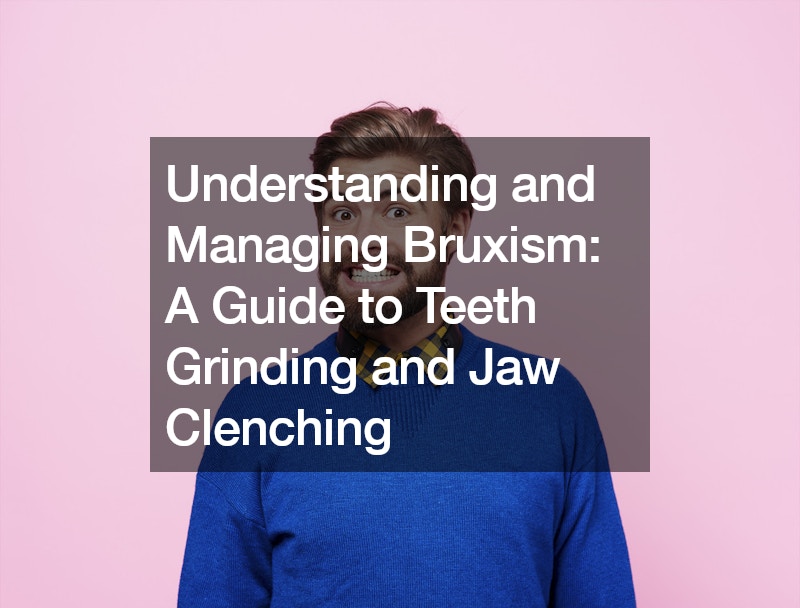

Bruxism, commonly known as teeth grinding or jaw clenching, is a prevalent yet often overlooked dental issue affecting millions of people worldwide. While it may seem like a harmless habit, bruxism can lead to significant dental problems and discomfort if left untreated. In this comprehensive guide, we delve into the causes, symptoms, and effective management strategies for bruxism.
Understanding Bruxism
Bruxism is the medical term used to describe the habitual grinding or clenching of teeth, typically occurring during sleep but can also happen during waking hours. This involuntary behavior can exert excessive pressure on the temporomandibular joint (TMJ) and surrounding muscles, leading to jaw pain, headaches, and even facial discomfort.
Identifying the Symptoms
Recognizing the symptoms of bruxism is crucial for early intervention. Individuals suffering from bruxism may experience:
- Jaw pain upon waking
- Sore or tired jaw muscles
- Flattened, chipped, or loose teeth
- Increased tooth sensitivity
- Headaches resembling migraines
- Facial pain or discomfort, often mistaken for an earache
Moreover, bruxism can manifest in various dental complications, including cracks, chips, and wear on tooth enamel. Dentists often notice signs of bruxism during routine dental examinations, such as tooth wear or recession, highlighting the importance of regular dental check-ups in detecting and addressing this condition.
Exploring the Causes
While the exact cause of bruxism remains unclear, several factors may contribute to its development. Stress emerges as a significant trigger, with emotional states like anger, frustration, and tension exacerbating teeth grinding and jaw clenching. Additionally, personality traits characterized by aggressiveness or hyperactivity may predispose individuals to bruxism.
Genetics also play a role, as bruxism tends to run in families. Furthermore, certain medical and mental health conditions, including sleep disorders like sleep apnea, Parkinson’s disease, and GERD (gastroesophageal reflux disease), are associated with bruxism.
Managing Bruxism
Effective management of bruxism involves a multifaceted approach aimed at addressing both the symptoms and underlying causes of the condition. Stress reduction techniques, such as mindfulness, relaxation exercises, and cognitive-behavioral therapy, can help alleviate bruxism-related tension and anxiety.
Improving sleep hygiene is essential for individuals experiencing sleep bruxism. Establishing a consistent sleep schedule, creating a relaxing bedtime routine, and avoiding stimulating activities before bed can promote better sleep quality and reduce nocturnal teeth grinding.
Protecting Teeth and Jaws
One of the most effective ways to mitigate the damaging effects of bruxism is through the use of a night guard. Night guards, also known as occlusal splints, are custom-fitted dental appliances designed to cushion and protect the teeth from excessive grinding and clenching during sleep.
Wearing a night guard not only safeguards teeth enamel but also helps alleviate jaw pain and headaches associated with bruxism. Dentists recommend wearing a night guard consistently, especially for individuals prone to sleep bruxism, to prevent further dental complications and promote overall oral health.
Seeking Professional Care
Regular dental visits are essential for individuals with bruxism to monitor their oral health and receive timely intervention. Dentists can provide valuable insights into managing bruxism, offer personalized treatment recommendations, and detect any signs of dental damage associated with teeth grinding and jaw clenching.
In cases where bruxism is linked to underlying medical or sleep disorders, collaboration with healthcare professionals, such as physicians or sleep specialists, may be necessary to address the root cause effectively.
Preventing Dental Complications
Aside from wearing night guards, adopting good oral hygiene practices can help prevent dental complications associated with bruxism. Regular brushing with a soft-bristled toothbrush and fluoride toothpaste, along with daily flossing, can help maintain oral health and reduce the risk of tooth decay and gum disease.
Exploring Alternative Therapies
In addition to conventional treatments, some individuals may benefit from complementary therapies for managing bruxism. Techniques such as acupuncture, massage therapy, and biofeedback have shown promise in reducing bruxism-related muscle tension and promoting relaxation.
Educating Others
Raising awareness about bruxism and its potential consequences is essential for promoting early detection and intervention. Educating family members, friends, and colleagues about the signs and symptoms of bruxism can encourage proactive dental care and prompt individuals to seek professional help when needed.
Conclusion
Bruxism poses a significant threat to dental health and overall well-being, yet with proper understanding and management, its detrimental effects can be mitigated. By recognizing the symptoms, addressing underlying stressors, and employing protective measures like night guards, individuals can take proactive steps to safeguard their teeth and jaws against the damaging effects of bruxism.
Remember, dental health is integral to overall health, and seeking regular dental care is crucial in preventing and managing conditions like bruxism. Together with the guidance and expertise of dentists, individuals can embark on a journey towards healthier teeth, happier smiles, and improved quality of life.
.
